Top>Opinion>The Future of Sixth Sector Industrialization as Seen from Sakura Shrimp Fishing in Yui, Shizuoka
 Index
Index

Emiko Tsuyuki【profile】
The Future of Sixth Sector Industrialization as Seen from Sakura Shrimp Fishing in Yui, Shizuoka
Emiko Tsuyuki
Professor, Chuo Graduate School of Strategic Management, Chuo University
Areas of Specialization: Organizational Theory, Strategy Theory, Entrepreneurship Theory
Introduction
A pink carpet spreads across the riverbed of the Fuji River. Sakura shrimp have been left out to dry, a common springtime sight in Suruga Bay. The bay is the only place in Japan where this native species of shrimp can be caught. The beautiful appearance of sakura shrimp has earned them the nickname “rubies of the sea.” The technique for sakura shrimp fishing is said to have been discovered by accident in 1894.
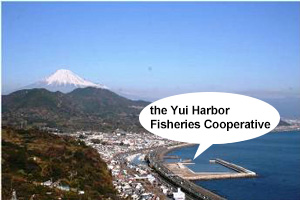
Photo 1: Photograph of the Yui Harbor Fisheries Cooperative (Source: Materials prepared by the Cooperative’s Junior Group)
Today, sakura shrimp fishing is only practiced in three areas of Shizuoka Prefecture: Yui, Kanbara and Oi River. The Yui Harbor Fisheries Cooperative (hereafter “the Cooperative”) acts as the center of this fishing industry. The sixth sector industrialization efforts of the Cooperative’s Junior Group are an attempt on the part of the fishers to personally process, manufacture and distribute the seafood they catch to markets in a value-added form.
Special Characteristics of Sakura Shrimp Fishing
Sakura shrimp live in deep ocean waters at a depth of 200 to 300 meters. At night, they rise and float at a depth of about 50 meters to feed on plankton, their source of food. Sakura shrimp fishing, also called “night trawling” (yobiki), involves casting a net between two boats to this depth where the shrimp rise to feed.
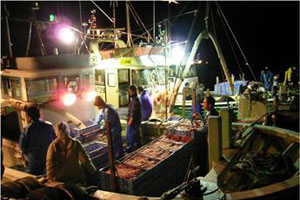
Photo 2: Sakura shrimp fishing (Source: Materials prepared by the Cooperative)
Sakura shrimp are not bred on farms, as their ecology is not well understood. There are two fishing seasons each year—the spring fishing season from mid-March to early June and the autumn fishing season from late October to late December for a total of about five months. Fishing is suspended during the rest of the year to conserve resources.
In addition, sakura shrimp fishing is operated through a voluntary arrangement among ship owners called a “pool system,” a type of fishery based on the resource management model. In this system, which was introduced about 40 years ago, all catches are equally distributed according to set rules among 120 ships licensed for fishing by the prefecture, in order to prevent over-fishing and accidents caused by excessive competition and to conserve resources. The activities of the Cooperative (Junior Group) cannot be understood without an awareness of the values and behavioral patterns shared by the fishers through cooperative work under this system.
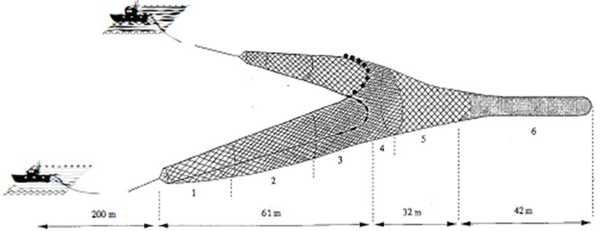
Figure 1: Two-boat trawling for sakura shrimp
The Efforts of the Yui Harbor Fisheries Cooperative
The Cooperative has been making efforts in sixth sector industrialization for over a decade, led by the fishers themselves. A representative example of these efforts is Hama no Kakiage-ya, a fishing market and restaurant directly managed by the Cooperative. The restaurant was apparently opened in response to all the questions from customers at the market on how to make sakura shrimp dishes. Located on the wharf of a fishing harbor close to the national highway, the restaurant allows visitors to leisurely enjoy sakura shrimp and whitebait dishes as they watch the boats in the harbor. It has become a popular attraction due to its simplicity and convenience, drawing many tourists to the area. The market and restaurant currently bring in annual sales of about two hundred million yen. The Sakura Shrimp Okizuke Bowl, a popular menu item, is a dish made with the Sakura Shrimp Okizuke (pickled sakura shrimp) developed by the Junior Group.
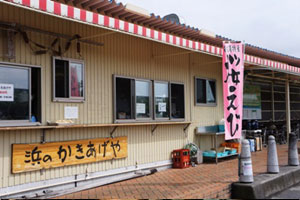
Photo 3: Hama no Kakiage-ya (fishing market and restaurant)
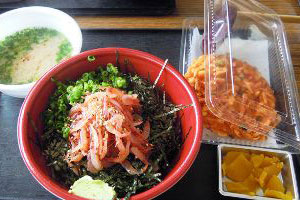
Photo 4: Sakura Shrimp Okizuke Bowl with kakiage (vegetable and seafood tempura)
Activities of the Junior Group (1)
The Cooperative’s Junior Group was launched in July 2008, bringing together the successors of all the fisheries in the Cooperative who were fifty years old and younger. The group was formed as a result of research and development on “live sakura shrimp” that began in 2006.
As mentioned earlier, the ecology of sakura shrimp is not well understood. The shrimp die soon after being caught, so keeping them alive in large numbers seemed impossible. The collaboration of a fisher and a university professor led to a solution, however. As a result of a three-way effort among fishers from the Junior Group, Professor Mitsuru Takasaki from Ishinomaki Senshu University who specializes in aquatic environment engineering, and engineers from farm equipment manufacturer Asaba Manufacturing in Nagano Prefecture, a device for keeping sakura shrimp alive was developed over a five year period. The project also gave the younger fishers more opportunities to meet in person and talk among themselves as they worked together toward their goal.
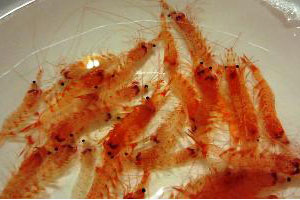
Photo 5: Live sakura shrimp
As live sakura shrimp were introduced in restaurants in Shizuoka and other local cities, their novelty attracted considerable attention. The shrimp were featured frequently in newspapers and on national TV, providing good publicity for domestically caught sakura shrimp. This achievement helped raise the value of the sakura shrimp brand.
Activities of the Junior Group (2)
The activities of the Junior Group are not limited to research, marketing and publicity efforts related to live sakura shrimp. They also include the organization of spawning surveys, sightseeing tours on fishing boats, and cooking classes centered on sakura shrimp.
The “Sakura Shrimp Okizuke” mentioned earlier is a product jointly developed by a Tokyo restaurant chain and the Junior Group. Okizuke is a special way fishers prepare and eat seafood in which the catch is immediately processed to preserve its freshness. During the 2012 spring fishing season, the Junior Group began experimental production using okizuke sauce provided by a restaurant chain with which they had a long-standing relationship. When they launched the product in September, it became a big hit, selling over 20,000 packs (at 1,000 yen per pack) over a roughly two-year period.
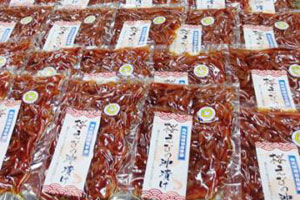
Photo 6: Sakura Shrimp Okizuke
The group concurrently worked on the development of another product—a fisher’s hanpen (pounded fishcake) with a slightly rough texture made from fish caught in local fixed nets. Released in January 2013 under the name Ryoshi-dama (Fisher’s Soul), the fishcakes are currently available at oden shops, izakaya chains, and local restaurants within Shizuoka Prefecture. The Junior Group continues to work on increasing the value they add to fish caught in fixed nets, which are caught in large quantities and traded at a cheap price each time.
The Potential of Producer-led Sixth Sector Industrialization
The activities of the Cooperative’s Junior Group, which was formed as a result of the live sakura shrimp project, have advanced through the direct efforts of active fishers at the beginning or middle of their careers. These activities are driven by the fishers’ desire for people to enjoy the seafood they catch in a fresh, delicious form and the idea that they must personally see the product through to the end to deliver that experience—from the management of raw materials to processing and marketing—rather than leaving those tasks to others.
This practice of fishers directly processing the fish they catch will help reassure consumers amid social problems such as fraudulent place-of-origin labeling. The series of activities has also enabled the establishment of new ties with local restaurants and processors, as well as restaurants and other establishments in the Tokyo metropolitan area and Shizuoka Prefecture, opening up even more possibilities.
The efforts of the Junior Group, launched by the live sakura shrimp project, have only just begun. However, with the growing instability of fishery revenue caused by the appearance of competing products like Taiwanese shrimp, declining catches and other problems, they represent a major step toward not only reaping the benefits of sakura shrimp catches, but optimizing the use of limited resources and directly engaging in the development and sale of value-added products.
Bibliography and Reference Materials
Tsuyuki, Emiko (2015). “Live Sakura Shrimp, Okizuke, and Ryoshi-dama: Case Studies on Fisher-Led Sixth Sector Industrialization by the Junior Group of the Yui Harbor Fisheries Cooperative [Jirei Kenkyū: Yui-kō Gyokyō Seinen-bu—Gyogyōsha ni yoru Roku-ji Sangyōka: Iki Sakura-ebi/Oki-zuke/Ryōshi-dama no Jirei],” Chuo Business School Review.
The Ministry of Agriculture, Forestry and Fisheries’ Sixth Sector Industrialization Web Portal (February 1, 2014)
Yui Harbor Fisheries Cooperative Website![]()
Episode of the educational program Chi no Kairo (Corridor of Knowledge) supervised by the author (“The Future of Sixth Sector Industrialization as Seen from Sakura Shrimp Fishing in Yui, Shizuoka [Yui no Sakuraebi-ryō ni Miru Roku-ji Sangyōka no Mirai]” (Episode 103))![]()
“Business School as a Place of Learning” (Chuo Online: Education; written on October 11, 2012)![]()
- Emiko Tsuyuki
Professor, Chuo Graduate School of Strategic Management, Chuo University
Areas of Specialization: Organizational Theory, Strategy Theory, Entrepreneurship Theory - Professor Tsuyuki completed the Master’s Program in Sociology at the Graduate School of Letters, Chuo University in 1991 and the Doctoral Program at the School of Knowledge Science, Japan Advanced Institute of Science and Technology (JAIST) in 2003, earning a PhD in Knowledge Science. She specializes in organizational theory, strategy theory, and entrepreneurship theory. After obtaining her master’s degree, she worked for an industrial machinery manufacturer for seven years. She then entered JAIST as a graduate student with working experience and studied under Professor Ikujiro Nonaka, an expert in knowledge management theory. From 2003 to 2007, she worked as a researcher at the Research Center for Venture Development Strategy, National Institute of Advanced Industrial Science and Technology. From 2005 to 2011, she served as an Associate Professor in the Department of Business Administration, School of Economics, Meisei University. At Meisei University, she oversaw the design and administration of project-based learning curricula like the Entrepreneurship Challenge Program. She assumed her current position at the Chuo Graduate School of Strategic Management (Chuo Business School) in April 2011.
Her (co-authored) publications include On Practice: Knowledge Creation and Utilization [Chishiki Keiei Jissenron], Academic Innovation [Akademikku Inobēshon], and High-Tech Startup Management Strategies [Haiteku Sutātoappu no Keiei Senryaku].
- Research Activities as a Member of Research Fellowship for Young Scientists (DC1), Japan Society for the Promotion of Science (JSPS) Shuma Tsurumi
- Important Factors for Innovation in Payment Services Nobuhiko Sugiura
- Beyond the Concepts of Fellow Citizens and Foreigners— To Achieve SDGs Goal 10 “Reduce Inequality Within and Among Countries” Rika Lee
- Diary of Struggles in Cambodia Fumie Fukuoka
- How Can We Measure Learning Ability?
—Analysis of a Competency Self-Assessment Questionnaire— Yu Saito / Yoko Neha - The Making of the Movie Kirakira Megane








